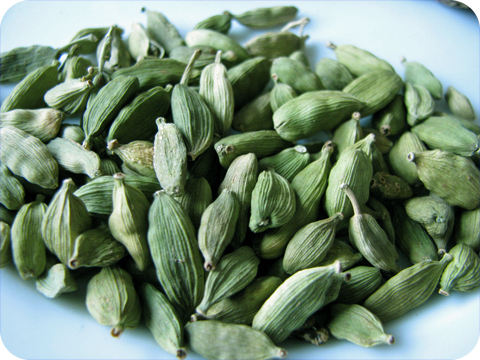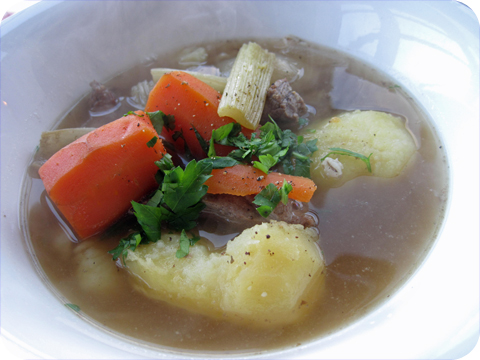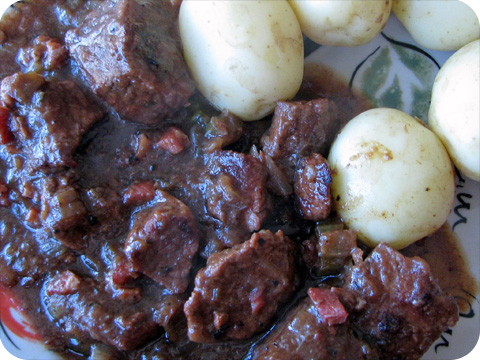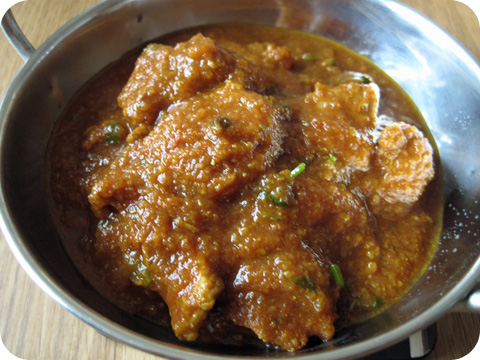
There’s an enthusiastic bunch of curryholics over on cr0.co.uk whose passion is reproducing the kind of curry dishes you’d find in a common-or-garden British Indian Restaurant (BIR). It’s a great website, containing recipes and discussions for the full range of BIR dishes. You name it, it’s there: onion bhajis, chicken tikka masala and saag aloo. The hottest topic on the website, however, has to be the creation of a “base” sauce. Indian restaurants in Britain will not typically cook their sauces (or gravies) freshly with each order. Preparing a curry from scratch would be too time-consuming. Instead, they will use a ladle or two of “base” and add extra ingredients to customise the dish: pre-cooked meat, tomatoes, extra spice, lentils etc. Indian gravies need to cook for some time in order to develop their flavour, but the use of a base sauce allows the restaurant to produce curries in no time at all.
While I admire the dedication of these enthusiasts, I can’t help chuckling at the lengths they go to in order to replicate dishes at home which are designed by restaurants to made as quickly and cheaply as possible. Surely all of their curries must taste the same? For me, the appeal of Indian food is the diversity of dishes available to the adventurous diner. Having said that, I understand the appeal of having producing some sort of basic curry sauce as it allows you to freeze or refrigerate portions for convenience. After a busy day at work, all you need to do is add some chicken or vegetables.
The difference between my curry “base” and those used by “The Star of Bengal” is that my sauce is delicious on it’s own. But you can still customise your curry depending on the style you prefer. Some variations are given in the notes below. This recipe will make enough for 12-15 servings.
I’ve found that when scaling up a dish, it’s not a case of simply multiplying all ingredients by “x”. There are some special considerations. Salt and any of the stronger spices (such as black pepper, chilli and garam masala) need to be added judiciously or else they may dominate the base sauce. I find it best to tread carefully with these items and adjust the flavours before serving the finished dish.
Ingredients
- 3 tbsp sunflower/groundnut oil
- 2 tbsp butter
- 1kg onions, chopped (about 4 very large onions)
- 16 large cloves garlic, peeled
- 100g root ginger, peeled
- 2 tbsp of each of the following: ground cumin, ground coriander, turmeric, paprika,
- 1 tbsp of each of the following: garam masala, dried fenugreek
- 2 tsp black peppercorns, ground
- 15 green cardamoms, crushed
- 10 cloves
- 4 black cardamoms
- 6 x 400g canned tomatoes
- 1 litre water
- 1½ tsp sea salt
Method
- Place a deep cast-iron casserole on the hob and heat the oil and butter. Cook the onions gently for around 30 minutes until soft and brown in colour. In the meantime, pre-heat the oven to 190°C.
- Chop finely or grate the garlic cloves and ginger. I use a mini-food processor for this.
- When the onions are brown and caramelised, add the garlic and ginger mixture and fry gently for a minute or two until softened. Add the ground spices and one can of tomatoes and stir-fry for a few minutes.
- Now remove the casserole from the heat and add the rest of the canned tomatoes. Using a stick blender, whizz the sauce until it’s very smooth.
- Put the casserole back on the heat and add the whole spices. Bring back up to a gentle simmer before covering the casserole and putting it in the oven for 1½ hours. I simply turn off the oven and leave the casserole in there overnight. Your reward is a sweet, deeply flavoured sauce. If you require a thinner consistency, just add some extra water.
Variations – Chicken and vegetables work best when de-frosting this curry sauce for a quick evening meal. Lamb and beef will take a little longer to cook, though that depends largely on the cut of meat you’re using. In my opinion, if you prefer meat curries it’s best to cook the sauce from scratch along with the lamb. Here are few of my favourite variations on restaurant and homestyle favourites.
- Vegetable – my favourite because it’s so easy to prepare. Add two handfuls of diced fresh vegetables for each portion of sauce. Finish the dish with a dollop of natural yoghurt or some lemon juice.
- Chicken – add a diced chicken fillet to each portion of sauce and simmer very gently until the chicken is cooked. Finish with a good sprinkle of homemade Garam Masala and a handful of chopped fresh coriander.
- Coconut – you can make a creamy chicken or vegetable curries can by adding 200ml coconut milk 5 minutes before the end of cooking.
- Saag – Make a spinach and chilli purée. Put 300g of spinach leaves in a large saucepan along with a splash of water. Place a lid on the saucepan and steam until the spinach has wilted down. Transfer the spinach to a liquidizer along with 2 chopped green chillies and any residual water from the spinach. Blend until smooth and add to the curry sauce. Add some dried fenugreek leaves and simmer gently for a few minutes. This makes an excellent addition to a chicken curry.
- Madras – Add some extra chilli powder and the juice of half a lemon and simmer for 5 minutes.
- Vindaloo – Adding lots of dried chillies, a slug of red wine vinegar and some cubes of fried potato. (Highly inauthentic of course, but delicious. Try this for a more authentic take on vindaloo.)
- Dhansak – Add a portion of tarka dal, brown sugar, lemon juice and some cubed pineapple.
Serves 12-15.





